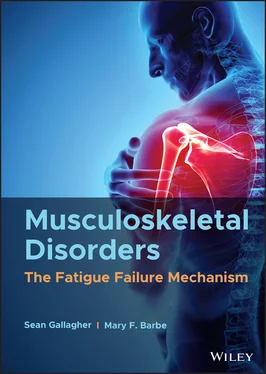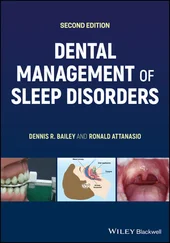Sean Gallagher - Musculoskeletal Disorders
Здесь есть возможность читать онлайн «Sean Gallagher - Musculoskeletal Disorders» — ознакомительный отрывок электронной книги совершенно бесплатно, а после прочтения отрывка купить полную версию. В некоторых случаях можно слушать аудио, скачать через торрент в формате fb2 и присутствует краткое содержание. Жанр: unrecognised, на английском языке. Описание произведения, (предисловие) а так же отзывы посетителей доступны на портале библиотеки ЛибКат.
- Название:Musculoskeletal Disorders
- Автор:
- Жанр:
- Год:неизвестен
- ISBN:нет данных
- Рейтинг книги:5 / 5. Голосов: 1
-
Избранное:Добавить в избранное
- Отзывы:
-
Ваша оценка:
- 100
- 1
- 2
- 3
- 4
- 5
Musculoskeletal Disorders: краткое содержание, описание и аннотация
Предлагаем к чтению аннотацию, описание, краткое содержание или предисловие (зависит от того, что написал сам автор книги «Musculoskeletal Disorders»). Если вы не нашли необходимую информацию о книге — напишите в комментариях, мы постараемся отыскать её.
Hands-on guidance and tools for the prevention of musculoskeletal injuries in the workplace Musculoskeletal Disorders: The Fatigue Failure Mechanism,
Musculoskeletal Disorders: The Fatigue Failure Mechanism
Musculoskeletal Disorders — читать онлайн ознакомительный отрывок
Ниже представлен текст книги, разбитый по страницам. Система сохранения места последней прочитанной страницы, позволяет с удобством читать онлайн бесплатно книгу «Musculoskeletal Disorders», без необходимости каждый раз заново искать на чём Вы остановились. Поставьте закладку, и сможете в любой момент перейти на страницу, на которой закончили чтение.
Интервал:
Закладка:
Medial elbow tendinopathy
Characteristics/description
Medial epicondylitis is an overuse tendinopathy due to chronic repetitive concentric or eccentric loading of the wrist flexors and pronator teres, resulting in angiogenic and fibroblastic changes (Kiel & Kaiser, 2019). Although epicondylitis is most commonly experienced on the lateral side of the elbow, certain activities (often occupational tasks) that cause repeated stress on the elbow can lead to pain and discomfort affecting the medial epicondyle. Pain associated with medial epicondylitis is often localized to the medial epicondyle, sometimes with radiation to the proximal forearm (Amin, 2015). Pain associated with medial epicondylitis is often increased in activities involving wrist flexion or pronation (Kiel & Kaiser, 2019) This pathology is due to the development of microtrauma and degeneration of the common flexor tendon and is most commonly seen in patients above 40 years of age (Amin, 2015). The prognosis for medial epicondylitis is generally quite favorable. Most patients can return to work or athletic activities after activity modification and/or physical therapy treatment (Kiel & Kaiser, 2019).
Epidemiology
Medial epicondylitis is much less prevalent than lateral epicondylitis; however, this disorder still accounts for approximately 10–20% of all epicondylitis (Shiri et al., 2006). According to one study, the prevalence in the general population is quite low, with only 0.4% afflicted. A significantly higher prevalence can be found in individuals participating in activities that repeatedly stress the tendons making up the common flexor tendon (i.e., the pronator teres, flexor carpi radialis, palmaris longus, flexor carpi ulnaris, and the flexor digitorum superficialis) (Kiel & Kaiser, 2019). In some occupational settings, the prevalence of medial epicondylitis has been found to range from 3.8 to 8.2% (Shiri et al., 2006; Descatha et al., 2003; Wolf et al., 2010). Three out of four cases are in the dominant arm. Medial epicondylitis is highest among subjects aged 45–64. Some studies suggest that the prevalence of this disorder in men and women appears roughly equivalent (Amin, 2015), but others have suggested greater prevalence in women (Kiel & Kaiser, 2019).
A study examining the prevalence of medial epicondylitis across five industrial sectors was reported by Descatha et al. (2003). This study indicated prevalence between 4 and 5%, with annual incidence estimated at 1.5% for this disorder. Forceful work was found to be a risk factor for medial epicondylitis but not exposure to repetitive work. Risk factors differed for medial and lateral epicondylitis. The prognosis for medial epicondylitis in this population was good with a 3‐year recovery rate of 81% (Descatha et al., 2003). A later study suggested that forceful and repetitive wrist bending, forceful gripping, and rotating/twisting actions of the forearm were significantly associated with medial epicondylitis (Descatha, Dale, Jaegers, Herquelot, & Evanoff, 2013). Odds ratios for these three physical factors were not significant for exposures less than 2 hr/day, but all were significant for exposures greater than 4 hr/day. These findings suggest that repetition (in combination with force) was an important factor in the development of medial epicondylitis in these workers.
Anatomy/pathology
The pathology associated with medial epicondylitis is similar to that of lateral epicondylitis; however, different activities may provide the requisite stress on the flexor tendons compared to those affecting the extensor tendons. As with medial epicondylitis repetitive activity leads exposure to forceful and repetitive activities is thought to lead to recurrent microtears in the tendon leading to the development of tendinosis. Although it was thought that the pronator teres and flexor carpi radialis were originally thought to be most commonly affected, more recent literature suggests all muscles may be equally affected, with the possible exception of the palmaris longus (Kiel & Kaiser, 2019). As the tendon undergoes repetitive microtears, there is remodeling of the collagen fibers and increased mucoid ground substance. Focal necrosis or calcification can occur. Subsequently, collagen strength decreases leading to increased fragility, scar tissue formation, and thickening of the tendon. Although less common, acute trauma can also cause medial epicondylitis from a sudden violent contraction of the muscles (Kiel & Kaiser, 2019).
Risk factors/activities associated with medial epicondylitis
Medial epicondylitis is sometimes referred to as “Golfers Elbow”; however, numerous other repetitive athletic activities such as overhead throwing, bowling, and weightlifting have also been associated with the development of medial epicondylitis. However, 90% of cases appear not to be associated with athletic activities (Kiel & Kaiser, 2019). Studies have demonstrated that occupational risk factors include activities repeatedly stressing the flexor tendons including wrist bending, rotational motions of the forearm, and forceful gripping are associated with medial epicondylitis.
Shoulder tendinopathy (rotator cuff)
Characteristics/description
Shoulder disorders are a common cause of occupational pain and disability in working populations. Rotator cuff disorders (RC) emerge as the dominant source of shoulder pain, accounting for an estimated 65–70% of all shoulder pain (Hales & Bernard, 1996). Symptoms of RC tendinopathy commonly include pain situated at the top and front of the shoulder or outer portion of the upper arm. Shoulder pain can progress from the anterolateral shoulder margin and lateral surface of the arm down to the elbow (Gumina et al., 2014). Pain can be exacerbated if the afflicted individual raises the arm or reaches back behind the body. These disorders are most commonly observed in middle‐aged to older patients. Injuries to the shoulder are associated with longer than average recovery times compared to other occupational MSDs with a median of 26 days of lost work. Night pain can occur in 83% patients, and 41% may experience muscle weakness (van Kampen et al., 2014).
Epidemiology
Several studies have been performed to assess the overall prevalence of shoulder pain in the general population. In general, prevalence rates tend to suggest overall prevalence rates of approximately 7–20% (Breivik, Collett, Ventafridda, & R., C., & Gallacher, D., 2005; Hasvold & Johnsen, 1993; Parsons et al., 2007; Pope, Croft, Pritchard, & Silman, 1997). In the workforce, MSDs involving the shoulder accounted for 14.9% of all work‐related MSDs in the United States in 2016, with heavy tractor‐trailer truck drivers and laborers/material movers having a greater proportion of injuries affecting the shoulder than other occupations (Bureau of Labor Statistics, 2018). However, certain personal characteristics have been shown to be influential in the experience of shoulder pain, particularly sex and age. Breakdown by sex show a consistently higher prevalence of shoulder pain in females than in males. Females typically have an approximately 10% higher prevalence than that reported in males (Breivik et al., 2005; Picavet & Schouten, 2003; Treaster & Burr, 2004). Age is another significant factor, with an increased general prevalence in older individuals and a notable increase of shoulder pain prevalence in the 45–64 age‐group (Pribicevik, 2012). In addition, adolescents aged 12–18 years appear to have a greater than average shoulder pain prevalence. In 2014, 88,980 nonfatal shoulder injuries and illnesses occurred that involved days away from work (Bureau of Labor Statistics, 2015).
Читать дальшеИнтервал:
Закладка:
Похожие книги на «Musculoskeletal Disorders»
Представляем Вашему вниманию похожие книги на «Musculoskeletal Disorders» списком для выбора. Мы отобрали схожую по названию и смыслу литературу в надежде предоставить читателям больше вариантов отыскать новые, интересные, ещё непрочитанные произведения.
Обсуждение, отзывы о книге «Musculoskeletal Disorders» и просто собственные мнения читателей. Оставьте ваши комментарии, напишите, что Вы думаете о произведении, его смысле или главных героях. Укажите что конкретно понравилось, а что нет, и почему Вы так считаете.




![Ally Carter - [Gallagher Girls 02 ] - Cross My Heart & Hope To Spy](/books/262178/ally-carter-gallagher-girls-02-thumb.webp)







![John Bruce - The Lettsomian Lectures on Diseases and Disorders of the Heart and Arteries in Middle and Advanced Life [1900-1901]](/books/749387/john-bruce-the-lettsomian-lectures-on-diseases-and-disorders-of-the-heart-and-arteries-in-middle-and-advanced-life-1900-1901-thumb.webp)